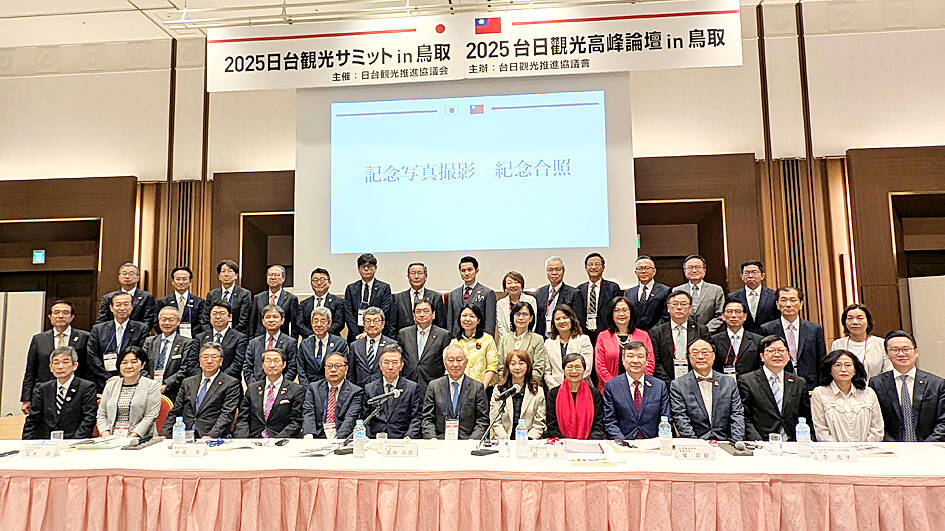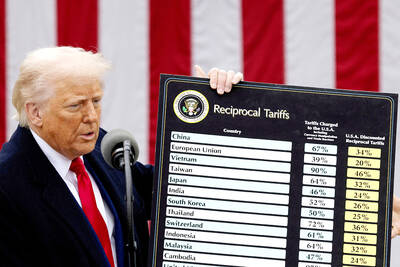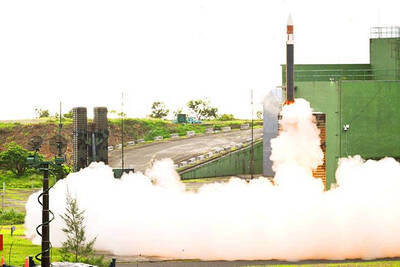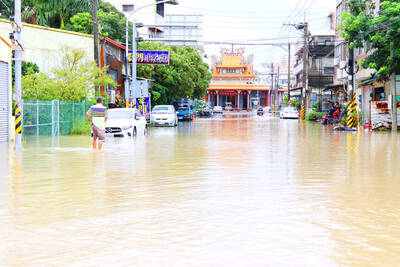The Tourism Administration yesterday announced a NT$10 billion (US$334.12 million) investment through 2030 to boost tourism to southern Taiwan, including the nation’s outlying islands.
Tourism Administration Director-General Chou Yung-hui (周永暉) made the comment at a forum in Japan’s Tottori Prefecture, saying that the plan is designed to draw more foreign tourists to areas that are not visited as much as places in Taiwan’s north.
The plan, dubbed Smiling Southern Taiwan (微笑南台灣), encompasses most of the nation’s subtropical territories, Chou said.

Photo: Lin Tsuei-yi, Taipei Times
It would allocate funding to museums of the arts and history in the south, he said.
It would also direct additional funding to places that showcase natural scenery or local culture, Chou said, adding that it has received provisional support from the Ministry of Transportation and Communications.
Tainan would receive NT$300 million in subsidies to thematically link Hatta Yoichi Memorial Park (八田與一紀念園), Wusanto Reservoir (烏山頭水庫), Zengwen Dam (曾文水庫) and hot springs in the area, and establish a visitor’s center for a proposed greenway at Taijiang National Park (台江國家公園), he said.
Hualien County would receive NT$300 million to improve the Yufu Biking Trail (玉富自行車道) in Yuli Township (玉里) and infrastructure for tourism in the county’s mountains, he said.
The agency would improve infrastructure at Kenting National Park in Pingtung County to boost visitor comfort and convenience, and build attractions revolving around fishing, as well as diving and other watersports in Penghu County, he said.
Taiwan’s target for this year is to draw 300,000 more Japanese to visit Taiwan than last year, Chou said.
The agency does not expect the goal to be easy to achieve, he said, adding that 1,319,892 Japanese visited Taiwan last year, up 42.2 percent from 2023, when travel was limited by restrictions during the COVID-19 pandemic.
An additional 300,000 Japanese arrivals would represent a 22.7 percent annual increase, well above the 6.6 percent increase achieved in the first half of the year, he said.
Japanese tourism to Taiwan has recovered to just 60 percent of pre-pandemic levels, he said, adding that the depreciating yen has dampened enthusiasm for travel.
Taiwan Visitors’ Association chairwoman Chien Yu-yen (簡余晏) said that it was important to enhance Taiwan’s appeal to international visitors and focus on quality experiences rather than purely numerical targets.
Chou and Chien attended the annual forum in Yonago from Thursday to today. They traveled on Tigerair Taiwan’s inaugural flight to the city.
Yonago is Tigerair’s 22nd destination. It has flights between the city and Taiwan every Monday and Friday.
Next year’s forum is to be held in Miaoli County.

WAITING GAME: The US has so far only offered a ‘best rate tariff,’ which officials assume is about 15 percent, the same as Japan, a person familiar with the matter said Taiwan and the US have completed “technical consultations” regarding tariffs and a finalized rate is expected to be released soon, Executive Yuan spokeswoman Michelle Lee (李慧芝) told a news conference yesterday, as a 90-day pause on US President Donald Trump’s “reciprocal” tariffs is set to expire today. The two countries have reached a “certain degree of consensus” on issues such as tariffs, nontariff trade barriers, trade facilitation, supply chain resilience and economic security, Lee said. They also discussed opportunities for cooperation, investment and procurement, she said. A joint statement is still being negotiated and would be released once the US government has made

NEW GEAR: On top of the new Tien Kung IV air defense missiles, the military is expected to place orders for a new combat vehicle next year for delivery in 2028 Mass production of Tien Kung IV (Sky Bow IV) missiles is expected to start next year, with plans to order 122 pods, the Ministry of National Defense’s (MND) latest list of regulated military material showed. The document said that the armed forces would obtain 46 pods of the air defense missiles next year and 76 pods the year after that. The Tien Kung IV is designed to intercept cruise missiles and ballistic missiles to an altitude of 70km, compared with the 60km maximum altitude achieved by the Missile Segment Enhancement variant of PAC-3 systems. A defense source said yesterday that the number of

Taiwanese exports to the US are to be subject to a 20 percent tariff starting on Thursday next week, according to an executive order signed by US President Donald Trump yesterday. The 20 percent levy was the same as the tariffs imposed on Vietnam, Sri Lanka and Bangladesh by Trump. It was higher than the tariffs imposed on Japan, South Korea and the EU (15 percent), as well as those on the Philippines (19 percent). A Taiwan official with knowledge of the matter said it is a "phased" tariff rate, and negotiations would continue. "Once negotiations conclude, Taiwan will obtain a better

FLOOD RECOVERY: “Post-Typhoon Danas reconstruction special act” is expected to be approved on Thursday, the premier said, adding the flood control in affected areas would be prioritized About 200cm of rainfall fell in parts of southern Taiwan from Monday last week to 9am yesterday, the Central Weather Administration (CWA) said. Kaohsiung’s Taoyuan District (桃源) saw total rainfall of 2,205mm, while Pingtung County’s Sandimen Township (三地門) had 2,060.5mm and Tainan’s Nanhua District (南化) 1,833mm, according to CWA data. Meanwhile, Alishan (阿里山) in Chiayi County saw 1,688mm of accumulated rain and Yunlin County’s Caoling (草嶺) had 1,025mm. The Pingtung County Government said that 831 local residents have been pre-emptively evacuated from mountainous areas. A total of 576 are staying with relatives in low-lying areas, while the other 255 are in shelters. CWA forecaster